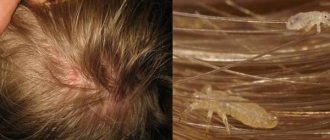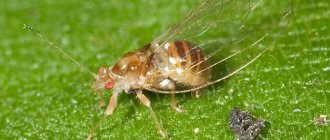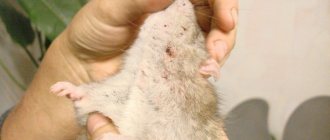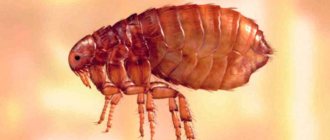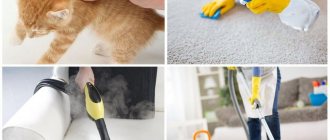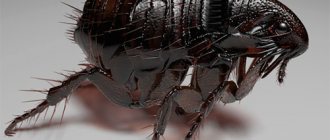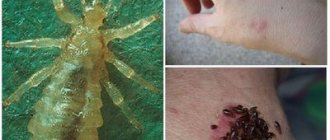- Who are we dealing with?
- Why do fleas appear in bed?
- How to detect linen fleas
- Are bed fleas dangerous?
- How not to deal with bed fleas?
- Two safe ways to eradicate insects from a bed Method 1. Temperature treatment of the bed
- Method 2. Folk remedies
Fleas can smell blood from a kilometer away. It is enough for one adult to jump onto a pet’s fur or into an open door, and within two weeks the home will be infested with annoying parasites. They settle in baseboards, carpets, bedding and even in the bedroom. So, you found fleas in your bed - how to get rid of these insects?
Who are we dealing with?
Researchers managed to describe 2086 species and 15 families of fleas. The name “bed flea” was coined by people who encountered insects in the bedroom. From a scientific point of view, this type of insect does not exist. The parasite that has settled in the bed belongs to the family of common fleas.
The insect is covered with a durable chitinous shell that cannot be damaged by simple pressure. The body is flattened laterally. The bristles and spines covering the limbs allow the flea to cling to the fur and skin of the victim. Thanks to their long hind legs and a special traction mechanism, fleas make high-speed and high jumps.
Parasites love to lay eggs not only on the pet’s fur, but also in secluded corners of the apartment. Larvae and pupae are distinguished by their vitality. They feed on decomposed organic matter (particles of dust and debris).
Consequences
The least damage caused by insects is red dots, swelling, and discomfort resulting from parasite bites. If the wounds are not treated and combed, there is a risk of infection; the scratched areas may fester.
There is a risk of inflammation of the lymph nodes, allergies, and anaphylactic shock. If negative symptoms appear, it is recommended to consult a doctor. The most serious danger from fleas is that they carry diseases:
- Anthrax.
- Typhus.
- Trypanosomiasis.
- Tularemia.
- Salmonellosis.
- Listeriosis.
- Encephalitis.
- Plague.
To avoid the occurrence of life-threatening infections, it is necessary to carry out sanitary treatment if harmful bed parasites appear in the house.
Knowing how to get rid of bed fleas, you can prevent their reproduction in a short time and protect yourself from existing fleas. Carrying out measures to get rid of insects will avoid negative consequences.
Why do fleas appear in bed?
First, the insect enters the home. For this, an intermediate link is needed.
- Pets walking outside;
- Basements;
- Human clothing and footwear;
- Neighbor's apartment;
- Open doors and windows in hot weather.
The parasite then finds a place suitable for living, feeding and reproducing. There are three reasons why fleas are attracted to human beds.
- Food source. A sleeping person practically does not react to bites. He lies quietly in bed, so the bed flea calmly drinks blood.
- Favorable place for laying eggs. Insects usually choose fleecy surfaces for such purposes. First, the eggs reliably stick to the bed linen and mattress, and then the resulting larvae and pupae feed on particles of the epidermis.
- Safety. During cleaning, a person carefully vacuums carpets, washes floors and baseboards, and wipes away dust. But he forgets to shake the mattress and clean the inside of the bed frame. Fleas calmly continue to live and reproduce.
Parasites love stale, damp bedding, garbage and dust under the bed.
Characteristics and appearance
Linen parasites are blood-sucking insects that live on humans. Young individuals have a reddish body, and at sexual maturity the fleas change color to black. The size of the parasites can reach 2 millimeters in length. In photos and in life, linen fleas can be recognized by the indicated external signs.
The lifespan of a flea is about 4 months. But sometimes parasites live up to one and a half years. Insects are active and tenacious. Small linen fleas, which are very difficult to get rid of, prefer cotton fabric and live well in unsanitary conditions. The growth and development of insects is stimulated by human warmth and the presence of clothing to which the parasites attach their eggs.
Insects are active and tenacious
The causes of fleas may vary. The first is the use of someone else's bedding that is infested with parasites. Insects can be brought into an apartment through someone else's clothing and through contact with contaminated things. At home, fleas multiply quite quickly, but identifying them is not easy, since after these parasites drink human blood, they hide in underwear.
One female can produce a whole group of fleas. Often, in order to get rid of parasites, you have to throw away your laundry, otherwise the colony will gradually replenish itself.
How to detect linen fleas
Sometimes people confuse bed fleas with other parasites (lice, bedbugs), and mosquitoes are blamed for the bites. You can detect harmful insects in the bed by the following signs.
- Small black dots on bed linen and mattress in the form of commas. This is flea excrement.
- Dark brown color of larvae. Unfortunately, it is almost impossible to notice pest eggs on bedding.
- Visual appearance of an insect. The length of the flea's body is a maximum of 5 millimeters, the color is dark brown or black. The insect jumps with such lightning speed that it creates a feeling of magical disappearance.
Preventing fleas
Prevention will help prevent an unpleasant neighborhood and protect yourself and your pets from pest invasion.
Compliance with the following rules will eliminate the appearance of insects:
- Maintain cleanliness in the linen closet at all times.
- Regularly treat carpets and upholstered furniture.
- Ventilate and dry pillows, blankets, and mattresses in the fresh air.
- Use high temperatures to wash and iron clothes.
- Dry-clean your outerwear periodically.
- Choose a flea collar for pets.
- When cleaning premises, do not miss hard-to-reach places.
- Avoid accumulation of garbage in the apartment.
By adhering to these rules, you can protect yourself and your home from bed fleas and other blood-sucking pests.
Are bed fleas dangerous?
Bed flea bites are painful. These parasites lack anesthetic enzymes, unlike other insects (lice, bedbugs, ticks). Nature has already endowed fleas with protective mechanisms: speed, agility, and a hard shell. Therefore, they do not have to hide and disguise themselves. If a person is bitten by a flea, he still won’t have time to kill the culprit.
During a bite, the parasite secretes a substance that prevents blood clotting. This allows him to get enough of it. Red spots with a black dot in the center and a pink halo form at the site of the bite. The wounds itch and heal painfully.
In children and some people, bed flea bites cause allergic reactions. In rare cases, the lymphatic system is affected, which leads to numerous inflammations on the skin.
Bed fleas are carriers of worms and dangerous diseases, including the following.
- Typhus;
- Encephalitis;
- Hepatitis B;
- Hepatitis C;
- Plague;
- Tuberculosis;
- Brucellosis.
Chemicals
The most popular option for getting rid of insects is the use of chemicals. When carrying out pest control yourself, you should use a special respirator and rubber gloves. Such precautions will help avoid inhalation of harmful substances and skin contact with the chemical.
To combat bed fleas, almost any substance that is designed to exterminate crawling insects is suitable. The most popular is Dichlorvos. But there are other drugs that differ in cost, toxicity, and application features.
What remedies will help you get rid of harmful parasites:
- Delta Zone - active ingredient - Deltamethrin. Allows you to get rid of not only fleas, but also cockroaches, flies, bedbugs, mosquitoes, and ants.
- Xulate Micro - active ingredients of the drug - PPB, Tetramethrin, Cypermethrin. Used in the fight against fleas, bedbugs, cockroaches.
- GET – active substance – Chlorpyrifos. Fights fleas, as well as cockroaches, bedbugs, ants and flies.
- Adamant – active substances – Malathion, Cypermethrin. Allows you to get rid of wingless insects such as fleas, bed bugs, ants.
Treatment with toxic drugs should be carried out in the absence of children and animals. It is better to put food products in the refrigerator or tightly closed cabinet so that the substance does not get on them.
Beds are treated with the selected preparation, especially in joints and crevices. You need to spray the product on the baseboards, cabinets, and clothes. The drug must be distributed, moving towards the exit. You should pay attention to the bathroom during the spraying process, as insects accumulate in damp rooms. The apartment must be left with the windows and doors closed for several hours.
After carrying out the treatment, after some time it is recommended to repeat the procedure - new fleas may hatch from the eggs that were previously laid by insects, then the previously carried out action will not bring results. It is better to postpone cleaning for several days; there is no need to wash the treated walls and floors of chemicals, this way the treatment will be more effective. It is recommended to wash bed linen, pet beds, and mattress covers at high temperatures.
If necessary, you can contact special SES services. They carry out disinfestation using special equipment; after the event, there is less chance that parasites will reappear.
How not to deal with bed fleas?
There are many insecticidal products sold in stores: aerosols, solutions, powders. You can find articles on the Internet about how to remove bed fleas using chemicals. However, the authors' recommendations are wrong.
After treatment, the insecticides will penetrate the mattress. As a result, it will become dangerous for a person to sleep on the bed due to possible contact of toxic substances with the skin and respiratory organs. Aerosols and concentrates are suitable for treating the apartment as a whole, and not for killing bed fleas. More cunning methods are needed.
Tips for choosing a disinfection service
The most reliable method of getting rid of bed fleas is the help of a professional disinfection service.
Specialists will quickly deal with parasites. This will save time and eliminate the need for contact with insecticides.
When choosing a disinfection service, you should pay attention to:
- The drugs used by the organization must be safe for humans and animals.
- The time for the procedure is chosen by the customer, not the company.
- The service clients are explained in detail the disinfection process, the chemicals used, and safety measures.
- Conscientious organizations work without prepayment.
- If the cleaning is unsuccessful, the customer does not pay for this event.
Services whose employees care about their reputation provide quality services, after which they receive only positive reviews.
Two safe ways to get insects out of your bed
How to get rid of fleas in bed without getting hurt yourself?
Method 1. Temperature treatment of the bed
Bed fleas hate two extremes: frost and heat. If it’s severe winter outside, open the windows in the bedroom and leave it like that for 2-3 hours. Not only the adults, but also the larvae will die out, leaving you to thoroughly vacuum the bed.
High temperatures will also help against fleas. Boil the bed linen and treat the mattress with a steam generator.
The bed body should be thoroughly cleaned of dust and washed with soap.
Method 2. Folk remedies
Bed fleas hate strong plant odors. Throw old bedding in the wash. Treat the mattress with 10 drops of any of the following essential oils:
- Eucalyptus,
- Tea tree,
- Pine,
- Fir,
- Lavender,
- Geranium,
- Mint,
- Anise.
Place dry twigs of wormwood or tansy in the bedroom. Fresh plants can be placed in a vase on the bedside table. Sleep for 2-3 days in another room. After that, go back to the bedroom and vacuum the mattress and under the bed. Do a general wet cleaning.
Please note that treating the bed for fleas alone is not enough. Perhaps some of the adult insects will move to other rooms and hide in carpets and baseboards. Therefore, the next step is to completely remove fleas from the apartment.
Getting rid of fleas on pets
Pets suffer from annoying flea bites even more than their owners. The parasites overwhelm the helpless animal, which is unable to get rid of them on its own. If even one insect remains on the fur, there will be no peace for all the inhabitants of the house. Shampoos, sprays, drops and collars are used to fight. Each product has its pros and cons, so before use you should consult a veterinarian, read information on the Internet, and also study the instructions:
- shampoo will help get rid of annoying fleas in one session. It is necessary to carefully read the instructions and monitor your pet’s behavior after using the drug. The process requires an individual approach, since the product can cause allergies in the animal. The downside is the lack of protection from relapse. If there is an external flea source, the insect may settle on the fur soon after washing. Therefore, it is recommended to “take baths” once a month in the summer, and once every three months in the winter;
Shampoos instantly relieve pets of fleas, but there is a possibility of recurrence - The spray kills fleas the first time. After treatment, you can not be afraid of a relapse for a long time, since parasites are afraid of a specific smell and sense it from a distance. The difficulty is in applying the product to the surface of the skin. Firstly, animals do not like such procedures. Secondly, the product can cause allergies or nervous disorders in your pet. Therefore, it is recommended to carefully read the contraindications in the instructions and pay attention to the behavior of the animal. If your pet reacts negatively to the product, you should choose another method;
Most often, sprays are applied to the animal’s withers, where it cannot reach with its tongue. - a collar is an effective measure, since insects react to the smell and do not approach the animal. A well-chosen collar will serve as reliable protection. But if its size is not chosen correctly, the consequences can be disastrous. A small headband will put too much pressure on the animal’s neck, making it difficult to breathe freely, leaving wounds and wearing away the fur. Large - will provoke a situation in which the pet can get caught on a sharp object. The pet itself can also react negatively to the smell of the collar - there are cases where poisoning occurred in animals wearing a collar. Therefore, this choice should be taken as responsibly as possible;
Collars can be both effective and dangerous. - Drops are the most harmless and effective method and are the most convenient. It is enough to apply a few drops to the withers, and your beloved pet will be freed from pests. The only condition is to carefully study the instructions and observe the animal’s reaction after using the drug.
All of the above remedies will be effective if they are used in combination with other methods. That is why it is recommended to follow the step-by-step instructions below:
- Treat the room where fleas live using chemical or folk remedies. Allow the required time to ensure the absence of not only living insects, but also their larvae. Do not allow animals into the treated area.
- Carefully treat the animal's habitat (rug, house, basket, etc.). It is advisable to boil the textile item in a soapy solution or wash it in a machine at high temperature. If the house is large, it must be treated along with general disinfection. The final point can be steaming with an iron.
- Treat the animal using the chosen method. After washing, let the wool dry naturally. Then it is recommended to carefully comb out the remaining insects with a special brush or glove.
During the necessary procedures, it is worth giving the pet the maximum amount of attention, because a temporary refusal from its usual place and a set of measures to care for its body are a huge stress for the pet - Once you are convinced of the final victory over the parasites, you can allow the animal into its usual habitat.
Preventive actions
Many flea remedies are indeed effective, but after some time the next generation of parasites may hatch and grow. To prevent such a nuisance from happening, it is better not to wash off the insecticide from the walls. If this is inconvenient, 2 weeks after the first treatment of the apartment it is worth repeating, then the parasites will not have a chance to breed again. For prevention purposes, you can place wormwood sprigs under your bed. The smell of this plant is unpleasant to fleas.
Ways to enter the apartment
Most often, fleas attack apartments on the first and last floors of houses, coming from basements and attics. Further settlement occurs through cracks and ventilation shafts. Fleas can enter the home through pets and on clothing.
You can find out what to do if your hamster has fleas.
In order to remove bed fleas, you probably need to repeat the treatment after a few weeks.

